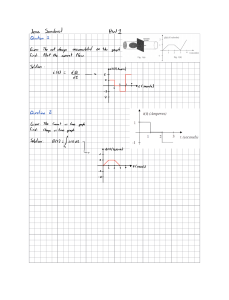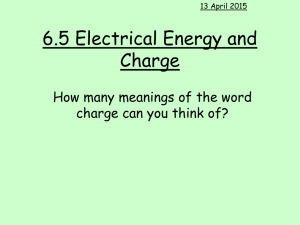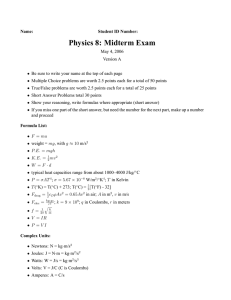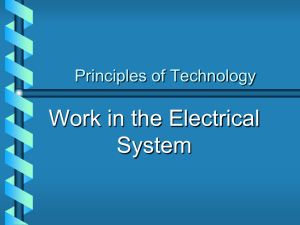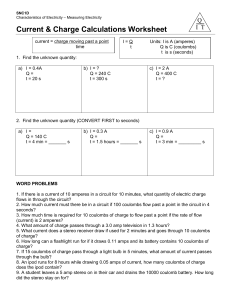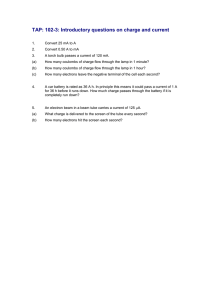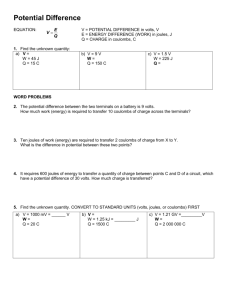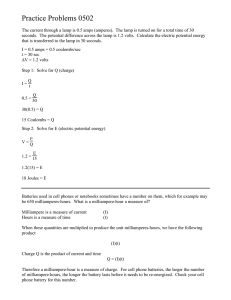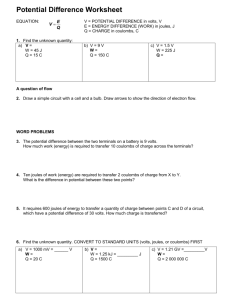Section 11.5: Electric Current
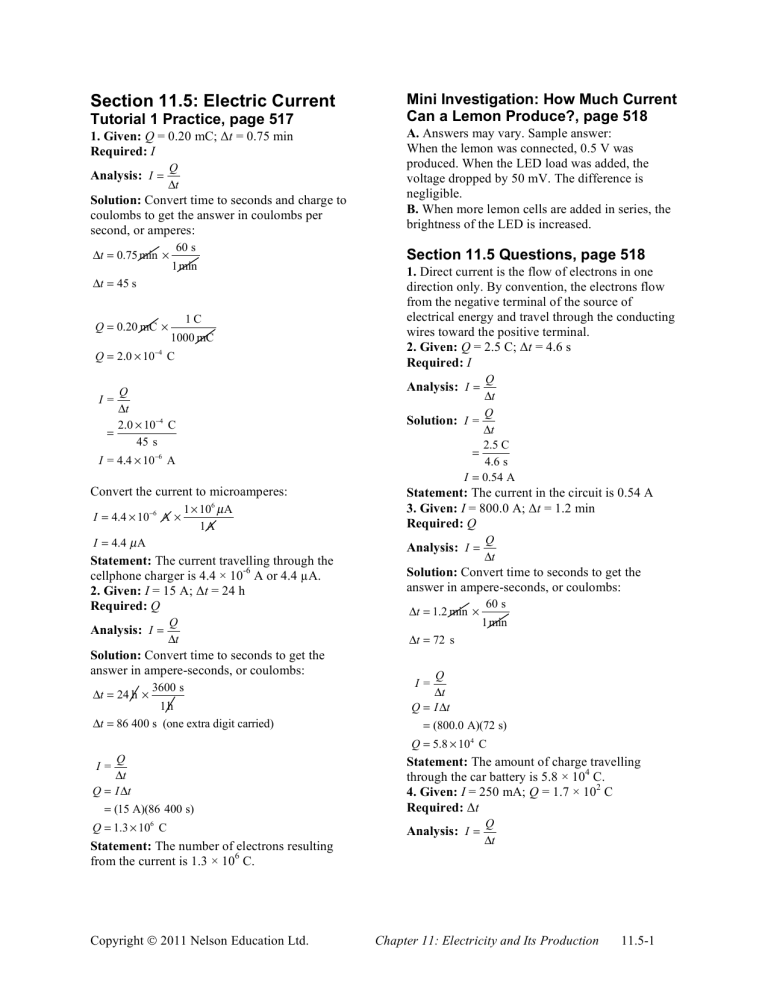
Section 11.5: Electric Current
Tutorial 1 Practice, page 517
1. Given: Q = 0.20 mC; Δ t = 0.75 min
Required: I
Analysis: I =
Q
!
t
Solution: Convert time to seconds and charge to coulombs to get the answer in coulombs per second, or amperes:
!
t = 0.75 min "
60 s
1min
!
t = 45 s
Q = 0.20 mC "
1 C
1000 mC
Q = 2.0
" 10 # 4 C
I =
=
Q
!
t
2.0
" 10 # 4
45 s
C
I = 4.4
" 10 # 6 A
Convert the current to microamperes:
I = 4.4
!
10 " 6 A !
1 !
10 6 µ A
1A
I = 4.4 µ A
Statement: The current travelling through the cellphone charger is 4.4 × 10
-6
A or 4.4 µ A.
2. Given: I = 15 A; Δ t = 24 h
Required: Q
Analysis: I =
Q
!
t
Solution: Convert time to seconds to get the answer in ampere-seconds, or coulombs:
!
t = 24 h "
3600 s
1 h
!
t = 86 400 s (one extra digit carried)
I =
Q
!
t
Q = I !
t
= (15 A)(86 400 s)
Q = 1.3
" 10 6 C
Statement: The number of electrons resulting from the current is 1.3 × 10
6
C.
Copyright 2011 Nelson Education Ltd.
Mini Investigation: How Much Current
Can a Lemon Produce?, page 518
A. Answers may vary. Sample answer:
When the lemon was connected, 0.5 V was produced. When the LED load was added, the voltage dropped by 50 mV. The difference is negligible.
B. When more lemon cells are added in series, the brightness of the LED is increased.
Section 11.5 Questions, page 518
1. Direct current is the flow of electrons in one direction only. By convention, the electrons flow from the negative terminal of the source of electrical energy and travel through the conducting wires toward the positive terminal.
2. Given: Q = 2.5 C; Δ t = 4.6 s
Required: I
Analysis: I =
Q
!
t
Solution: I =
Q
!
t
2.5 C
=
4.6 s
I = 0.54 A
Statement: The current in the circuit is 0.54 A
3. Given: I = 800.0 A; Δ t = 1.2 min
Required: Q
Analysis: I =
Q
!
t
Solution: Convert time to seconds to get the answer in ampere-seconds, or coulombs:
!
t = 1.2 min "
60 s
1min
!
t = 72 s
I =
Q
!
t
Q = I !
t
= (800.0 A)(72 s)
Q = 5.8
" 10 4 C
Statement: The amount of charge travelling through the car battery is 5.8 × 10
4
C.
4. Given: I = 250 mA; Q = 1.7 × 10
2
C
Required: Δ t
Analysis: I =
Q
!
t
Chapter 11: Electricity and Its Production 11.5-1
Solution: Convert current to amperes to get the answer in coulombs per ampere, or seconds:
I = 250 mA !
1 A
1000 mA
I = 0.25 A
I =
Q
" t
Q
" t =
I
=
1.7
!
10 2
0.25 A
" t = 680 s
C
Convert the time to minutes:
!
t = 680 s "
1 min
60 s
!
t = 11 min
Statement: The battery can produce the current for 680 s or 11 min.
5. Given: Q = 150 µ C; I = 0.21 mA
Required: Δ t
Analysis: I =
Q
!
t
Solution: Convert charge to coulombs and the current to amperes to get the answer in coulombs per ampere, or seconds:
Q = 150 µ C !
1 C
1 !
10 6 µ C
Q = 1.5
!
10 " 4 C
I = 0.21mA
!
1 A
1000 mA
I = 2.1
!
10 " 4 A
I =
Q
# t
Q
# t =
I
=
1.5
!
10 " 4
2.1
!
10 " 4
# t = 0.71 s
C
A
Statement: The time required for the charge to pass through the LED light is 0.71 s.
6.
First find the charge of the battery. Convert current to amperes and time to seconds to get the answer in coulombs.
I = 2650 mA !
1 A
1000 mA
I = 2.65 A
Copyright 2011 Nelson Education Ltd.
!
t = 1h "
3600 s
1h
!
t = 3600 s
I =
Q
!
t
Q = I !
t
= (2.65 A)(3600 s)
Q = 9540 C (two extra digits carried)
Now find the time it takes for 159 C of charge to deplete with a current of 883 mA. Convert current to amperes to get the answer in seconds.
I = 833 mA !
1 A
1000 mA
I = 0.833 A
I =
Q
" t
Q
" t =
I
=
9540 C
0.833 A
" t = 1.15
!
10 4 s (two extra digits carried)
Convert the time to hours:
!
t = 1.15
" 10 4 s "
1 h
3600 s
!
t = 3 h
So, the battery could produce a current of 883 mA for 3 h.
7. The student connected the ammeter in parallel so there is more than one path for the current to flow along. It is possible that the path passing through the ammeter has a much lower resistance than the path it is connected in parallel with, causing a large amount of current to take this path and resulting in a high reading.
8. Electric current is the conduction of free electrons in a material. If the material does not contain free electrons, then the material is not an electrical conductor. Therefore, no electric current can be produced in an non-conductor.
9. Electricians turn off the power to a circuit before working on it for safety. A current above 0.075 A is extremely dangerous when it flows into the body, and this is below a typical household circuit current rating. An electrician must always turn off the power to avoid accidental contact with an exposed wire or short-circuited electrical component.
Chapter 11: Electricity and Its Production 11.5-2
